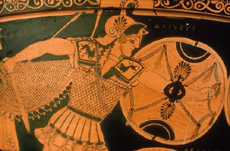Bibliography
Bibliography, the Iliad
by Steve JolivetteAll of the books below are in paperback and are readily available or easily ordered (the approximate prices I list below are from Barnes and Noble before their usual 10% discount).
Translations (listed by translator, roughly in order of preference)
- Lattimore, Richmond. The Iliad of Homer (1951; U. of Chicago P., 1961) $10
- Rieu, E.V., The Iliad (Penguin Classics, 1950) $10
- Hammond, Martin, The Iliad (Penguin Classics, 1987) $11
- Butler, Samuel, The Iliad (1898; Dover Thrift Editions, 1999) $2.50 (uses Latin names)
- Fagles, Robert; intro. and notes Bernard Knox. The Iliad (Penguin Classics, 1990) $9
- Fitzgerald, Robert. The Iliad (Anchor, 1974, 1989) $9
- Rouse, W.H.D. The Iliad (Signet, 1950) $6
- Lombardo, Stanley. The Iliad (Hackett, 1997) $11
Companions and Guides
- Willcock, Malcolm M., A Companion to the Iliad (U. of Chicago P., 1976) $12
- Monarch Notes: The Iliad (Monarch Notes) (Barnes & Noble Books, 1997), 160 pp. $4
- Cliffs Notes: The Iliad (Cliffs Notes) (Cliffs Notes, 1986), 68 pp. $4.50
Recommendations
I recommend the Richmond Lattimore translation. It translates the Greek text line for line, in (loose) meter form. At its best, I think it captures the language and style of Homer better than the others. However, it is difficult reading. I find many passages unintelligible. I do not necessarily recommend it for everyone. (It also has a particularly good introductory section.)
There are some remedies for the unintelligibility problem:
(a) The E.V. Rieu translation is a prose translation which is much clearer than Lattimore. (I use it when I cannot understand Lattimore.) It tries to capture as much of Homer as is possible in prose, while still being clear. You lose some epic grandeur in this kind of prose translation, but more than enough of it is preserved. If you find Lattimore too difficult and/or simply not to your taste, by all means, use Rieu. I could say almost the same thing for the Hammond translation as for the Rieu. But it has a blander style and word choice which is less close to Homer. The Butler translation is good, but often harder to read than Rieu or Hammond. I list it because of its very low cost; however there is no supporting material, not even a glossary of names, and it uses Latin names for the characters.
(b) Malcolm M. Willcock, A Companion to the Iliad . Using Lattimore's translation as a source, Willcock explains many points and issues in the Iliad, large and small. An invaluable guide, especially if you are really studying the epic. But even if you are not studying it, many passages or issues may strike you as too important to be ignorant of or unclear about; so you may find this companion indispensable.
If you are skipping chapters, read the outline of the story you are missing in the Monarch Notes guide. (I think Monarch Notes is far better than Cliffs Notes because its chapter outlines are much longer; Cliffs's are too short.)
Both Monarch Notes and Cliffs Notes have useful background and introductory information.
Other translations
Both Fagles and Fitzgerald attempt a poetic translation. Fagles is far the better of the two. He is generally more clear than Lattimore. So is Fitzgerald, but barely so. Both suffer from playing very fast and loose with Homer's style, diminishing his epic grandeur and coming up with formulations which seem weird to me. Fitzgerald is especially bad in this regard.
Rouse's prose translation is probably the clearest of all the translations, and the shortest, since he drops many of the epithets. It is the easiest to read of all the translations. He uses very plain English and even colloquial English, thus losing much of the grandeur of Homer's style. But he does not deliberately undercut Homer, so this translation is quite acceptable and may be the best option for some people. The poetic translation of Stanley Lombardo has all the virtues and all the defects of Rouse. It probably strays a little further from Homer than Rouse, but some people may prefer its fast-paced poetic style.
Recommended Readings, the Iliad
For those who cannot read or do not wish to read all of the Iliad, I suggest the following books (chapters) as most important:
- bks. 1-4 (skipping the "Catalog," Bk. 2, lines 484-877). A very good introduction to the Iliad.
- * bk. 6, lines 390-502 (Hector, Andromache, and Astyanax scene)
- * bk. 9
- bk. 14, lines 153-351 (The Deception of Zeus)
- bk. 16
- * bk. 18
- bk. 20, lines 364-503 (Combat of Achilles and Hector)
- * bks. 21-22
- * bk. 24
That is less than 45% of the Iliad. The items with an asterisk (*) are the most important of these, and bring the amount down to perhaps one-third. Cutting still further, books 1-4 (minus the "Catalog" in book 2) provide a good introduction to the Iliad and its main story line; from this, you can get a sense of the Iliad. If you are really short of time, it would be a shame not to get some idea of the Iliad-read bk. 1!
But if you are skipping books, fill in the gaps with the Monarch Notes chapter summaries of the story. In addition, reading through these story summaries, you might spot other parts which look particularly interesting to read.
See Also
Links
copyright © 2024 Andrew Layman, all rights reserved, 1/15/2024 6:10:42 PM, Topic: Bibliography, the Iliad, http://www.strongbrains.com
